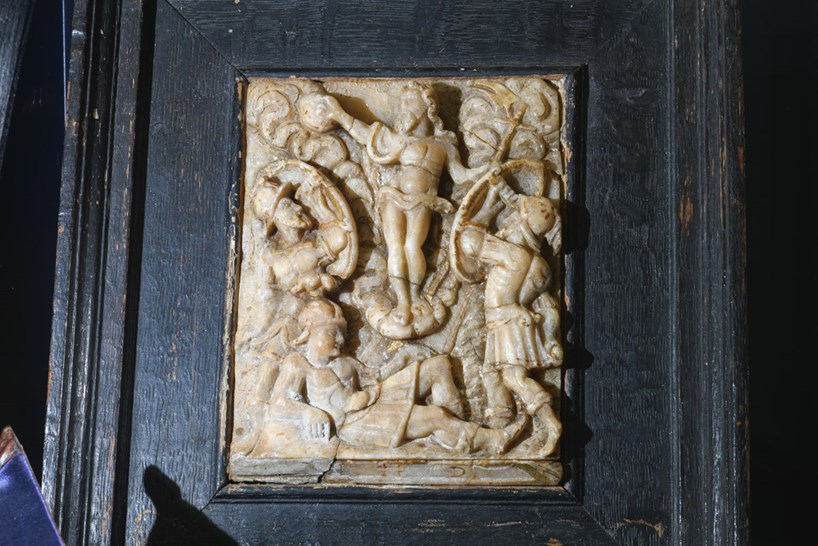“RELIGION, Rebellion and Reformation”: when I first heard this, the title suggested to me that this would be a further long-overdue attempt to rehabilitate the memory of the saintly Bishop George Bell (1929-58), after he was posthumously vilified by leading churchmen on the basis of groundless accusations.
In Chichester, in October 2023, 4 Canons Lane was again named George Bell House. It is adjacent to the medieval gatehouse leading to the bishop’s palace.
The small exhibition along the cathedral’s north aisle sets out to tell something of the history of the see of Chichester since the bishop’s cathedra was moved here in 1075, from Selsey, on the coast. At its heart, we are reminded of Bishop Bell; his episcopal ring and pectoral cross, simply engraved in the style of Eric Gill with two weeping angels either side of the Crucified, are included as two secondary “touch” relics.
The one relic on display is also the oldest work in the show. The 17th-century crystal cross encloses a piece of the True Cross. Bishop Bell kept it on his desk throughout his years in office as a “True Pastor Poet and Patron of the Arts Champion of the Oppressed and Tireless Worker for Christian Unity”, as his 1961 memorial tablet rightly proclaims.
The focus of the exhibition is not just on the diocese and begins with the alarming (and inaccurate) claim: “In the New Testament, bishops [my italics] oversaw small Christian communities and later became responsible for dioceses.”
Fast forward to seventh-century England when St Theodore of Tarsus, Archbishop of Canterbury, provided for parish and diocesan structures across the kingdoms of England. In 681, lands along the south of England came under the control of a bishop based at Selsey.
As part of the Norman Conquest and the landgrab of the French, many of the Anglo-Saxon structures of Church were dismantled. Bishops and abbots had long offered godly counsel to the kings in England. Now they were to be subject to them and to govern as local representatives of a centralised power. The former Roman city of Noviomagus Reginorum made Chichester a more powerful base than Selsey. At the eastern end of the diocese, there are six cathedrals closer than the mother church in Chichester, not all of them in England.
 Chichester CathedralA 15th-century alabaster carving of the resurrection, held by Chichester Cathedral, which is in the exhibition
Chichester CathedralA 15th-century alabaster carving of the resurrection, held by Chichester Cathedral, which is in the exhibition
From the Norman times come two crosiers, the rare, simply worked jet head of one bishop’s staff, possibly of Bishop Seffrid II, and another (also 12th-century) in gilt with a winged gryphon. The Welsh-born Bishop Reginald Pecocke (1395 -1461), the only pre-Reformation bishop to be deprived for heresy (1457), is remembered here with the later 17th-century puritan printing of one of his banned books, A treatise proving that Scripture is the only rule of faith.
To demonstrate the changes engulfing the Church of the Reformation, we encounter Anne Tree, who was burned at the stake in East Grinstead High Street in July 1557; and we get to see both a 1613 copy of the Authorised Version of 1611 and a Book of Common Prayer (1639) that William Sancroft, later Archbishop of Canterbury, marked up in 1661 with his suggested changes to the rubrics and prayers for private baptism and the order of confirmation.
It would be fascinating to see these changes as work in progress alongside the 1662 version. The so-called “Fair Copy” with Sancroft’s significant changes marked up on a 1634 folio BCP is kept in Oxford, in the Bodleian Library (Auct. V. 3.16).
The chalice and paten that John Ashburnham (1602/3-71) gave to his parish church, St Peter’s, Ashburnham, is a salutary reminder of how even after the Reformation that preached against purgatory many thought that good works might save them.
Jack Ashburnham, as Charles I fondly called him, had been a teenage protégé of the Duke of Buckingham in the dying days of the court of James VI and I and a Groom of the Bedchamber. He enriched himself in the 1620s and 1630s as a moneylender and by buying up landed estates at less than the market rates. After the Restoration, his loans to Charles I were repaid by assigning him yet more leases such that he could rebuild his family estates in East Sussex and St Peter’s in 1665. As a former MP, he could have been the very model of a modern Church Commissioner.
The little exhibition is part of the cathedral’s celebration of 1075-2025. For the new Dean, the Very Revd Dr Edward Dowler, nine (and a half) treasures highlight the life of the place, among them the remarkable Romanesque relief carvings of the raising of Lazarus; the 14th-century Arundel tomb (cf. Philip Larkin); the 1978 Chagall window; and, more recently, the mosaic of St Dominic (2022), crafted by James Blackstone and Martin Earle of the Chichester Workshop for Liturgical Art. The cathedral still, 950 years on, speaks of God to his people.
“Religion, Rebellion and Reformation” runs at Chichester Cathedral until 15 November. www.chichestercathedral.org.uk

















